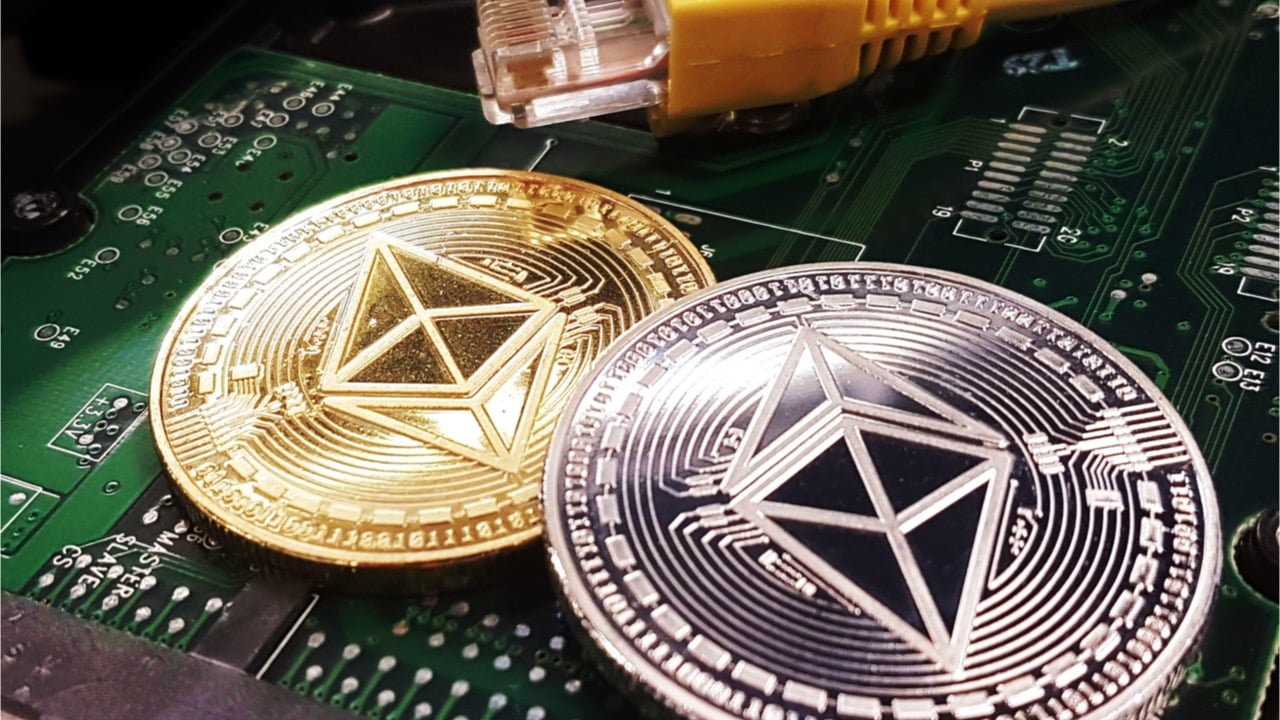 On Wednesday, the stock and cryptocurrency trading platform Robinhood rolled out recurring crypto investments and now customers can purchase as little as $1 in crypto commission-free daily, weekly, biweekly, or monthly. The company’s announcement discusses the strategy of investment called dollar-cost averaging “in order to help smooth out the price swings.” Robinhood Rolls Out Recurring […]
On Wednesday, the stock and cryptocurrency trading platform Robinhood rolled out recurring crypto investments and now customers can purchase as little as $1 in crypto commission-free daily, weekly, biweekly, or monthly. The company’s announcement discusses the strategy of investment called dollar-cost averaging “in order to help smooth out the price swings.” Robinhood Rolls Out Recurring […] The Ethereum 2.0 contract now has more than 7.4 million ether worth over $29.3 billion using today’s ether exchange rates. According to statistics, the smart contract address is the largest holder of ethereum out of all the wallets in existence. Ethereum 2.0 Contract Nears $30 Billion In the early days, the Ethereum (ETH) protocol was […]
The Ethereum 2.0 contract now has more than 7.4 million ether worth over $29.3 billion using today’s ether exchange rates. According to statistics, the smart contract address is the largest holder of ethereum out of all the wallets in existence. Ethereum 2.0 Contract Nears $30 Billion In the early days, the Ethereum (ETH) protocol was […]
Cream Finance has identified the AMP integration error that caused a nearly $19 million loss for the protocol and aims to pay users back.
Decentralized finance (DeFi) protocol Cream Finance will pay back its users following a $18.8 million flash loan hack that occurred on Aug. 30.
Cream has published a post-mortem to the AMP flash loan exploit, promising to replace the stolen Ether (ETH) and Amp (AMP) tokens by allocating 20% of all protocol fees until the debt is paid entirely. Cream will also post collateral with relevant parties at AMP and its creators, Flexa digital payments network, to secure the debt.
According to the post-mortem report, the latest flash loan exploit was the first time Cream Finance has suffered a direct exploit, losing 462 million AMP tokens and 2,800 ETH. With assistance from blockchain security firm PeckShield, Cream found that the exploit was caused by an error in the way the protocol integrated AMP. “While unfortunate and disappointing, we take ownership of the error,” Cream noted.
Alongside a main exploit, Cream has also discovered a smaller copy-cat attack from an address with transaction history on Binance crypto exchange. The crypto trading platform is now cooperating with Cream to identify the second perpetrator.
Cream said that it will be working with authorities to trace the attacker and work with law enforcement authorities to prosecute “to the fullest extent of the law.” The hacked protocol will also grant a 10% bug bounty to the exploiter if they decide to send back the stolen funds. “If anyone is able to identify and provide information leading to the arrest and prosecution of the exploiter, we will share 50% of all funds returned,” Cream added.
Related: Poly Network offers to on board 'Mr. White Hat' as chief security advisor
As previously reported, Cream halted supply and borrow contracts on AMP on Aug. 30 to stop the exploit that allowed the attacker to gain access to nearly $19 million in AMP and ETH through reborrowing assets in just 17 separate transactions. Prices of both Cream’s native token, CREAM, and AMP subsequently dropped, with AMP plummeting nearly 13%.
The affected tokens continued declining in price following the attack. At the time of writing, CREAM is trading at $159, down 11% over the past seven days, according to CoinGecko. AMP token is down nearly 15% over the same period, trading at $0.052525.
 Approximately 25 days ago, the Ethereum blockchain implemented the London hard fork and a number of features were added to the ruleset. One of the most anticipated changes was EIP-1559 which makes the crypto asset ether deflationary by burning a fraction of coins. Since August 5, over $432 million worth of ether has been burned, […]
Approximately 25 days ago, the Ethereum blockchain implemented the London hard fork and a number of features were added to the ruleset. One of the most anticipated changes was EIP-1559 which makes the crypto asset ether deflationary by burning a fraction of coins. Since August 5, over $432 million worth of ether has been burned, […] Following the bug and the split that occurred after a great number of Geth nodes did not upgrade, Ethereum fees have risen dramatically since August 21, jumping from $11 per transaction to today’s 0.0088 ether per transaction ($27.98). Ethereum Transaction Fees Skyrocket Ethereum is the second-largest crypto asset in terms of crypto market capitalization with […]
Following the bug and the split that occurred after a great number of Geth nodes did not upgrade, Ethereum fees have risen dramatically since August 21, jumping from $11 per transaction to today’s 0.0088 ether per transaction ($27.98). Ethereum Transaction Fees Skyrocket Ethereum is the second-largest crypto asset in terms of crypto market capitalization with […]
1inch indicated that its launch on the Optimistic Ethereum network will lead to faster confirmation times and lower fees.
Decentralized exchange aggregator 1inch has announced its deployment on the Optimistic Ethereum, or OE, mainnet, highlighting a considerable reduction in user transaction fees and confirmation delays.
Sergej Kunz, co-founder of the 1inch Network stated “the 1inch launch on Optimistic will facilitate a dramatic increase in transaction speed."
While deposits utilizing the OE network are set to be credited almost instantly, withdrawals will require a waiting period of 7 days. These wait times are expected to improve in future when fast withdrawal service is enabled.
At the time of launch, the OE network will only be able to handle 0.6 transactions per second. However, the team expects to progressively increase transaction speeds after testing and optimizing the infrastructure. The update will be compatible with most Ethereum wallets, including MetaMask and WalletConnect.
Optimistic Ethereum is a layer 2 scalability solution developed by the Optimism team. The Optimism team is a Public Benefit Corporation that researches scalability solutions on the Ethereum network. The OE solution itself is an EVM-compatible Optimistic Rollup chain.
1inch is not the only exchange to integrate Optimism’s layer-2 solution. On July 13, AMM Uniswap deployed the alpha version of its V3 exchange on the same Optimistic Ethereum mainnet.
 The Ethereum blockchain has completed the highly anticipated London upgrade on Thursday and ether fans have been discussing the protocol’s burn rate with great fervor following the fork. 5.9 Ether Is Burned Every Minute, Vitalik Buterin ‘Confident’ About the future after London At press time, Ethereum is burning 5.9 ether per minute or $16.8K using […]
The Ethereum blockchain has completed the highly anticipated London upgrade on Thursday and ether fans have been discussing the protocol’s burn rate with great fervor following the fork. 5.9 Ether Is Burned Every Minute, Vitalik Buterin ‘Confident’ About the future after London At press time, Ethereum is burning 5.9 ether per minute or $16.8K using […]
The much-talked-about London upgrade has finally happened on the Ethereum network as ETH arguably moves closer to becoming a deflationary asset.
The London hard fork arrived almost on schedule at 12:33 pm UTC on Thursday at block height 12,965,000, ushering in the Ethereum Improvement Proposal (EIP) 1559.
With the upgrade triggered, Ethereum will now undergo a significant overhaul of the network’s transaction fee market and other parameters such as gas refunds among others.
Under EIP-1559, each transaction on Ethereum will involve burning the base fee, which automatically decreases the Ether (ETH) circulating supply. Several exchanges, including Binance, announced a temporary pause to deposit and withdrawals on the Ethereum network due to the London hard fork.
Some proponents of the upgrade say it will catapult Ether to becoming a deflationary asset, as each transaction will trigger a portion of the total coin supply to be removed from circulation forever.
As previously reported by Cointelegraph, Ethereum co-founder and ConsenSys founder Joseph Lubin described the London upgrade as a part of a journey toward making Ether become “ultrasound money.”
The London upgrade and the subsequent activation of EIP-1559 is a mile marker of sorts in the transition to Ethereum 2.0, which will move the network from a proof-of-work consensus to a proof-of-stake consensus.
After the London upgrade engineers block elasticity and overhauls the transaction fee market, the Shanghai hard fork scheduled to happen later in the year will be the next focus point on the agenda.
Related: Ethereum’s London, Berlin and Shanghai forks and their role in Serenity
The excitement surrounding the upgrade has coincided with a steady increase in the ETH spot price. With a price hovering around $2,610 at publication time, the second-largest crypto by market capitalization is at its highest price level since early June.
Ether clocked an all-time high above $4,200 back in mid-May right before the crypto price crash that saw Bitcoin (BTC) lose about 50% and altcoins declining by over 70% on average.

Think Ethereum is going to morph into a deflationary asset over night? Not so fast!
Ethereum’s London upgrade is set to activate on Thursday, according to the countdown available on Ethereum.org. “The London upgrade is scheduled to go live on Ethereum in August 2021, on block 12,965,000,” Ethereum.org reads. “It will introduce EIP-1559, which reforms the transaction fee market, along with changes to how gas refunds are handled and the Ice Age schedule.”
Ethereum Improvement Proposal 1559, or EIP-1559, will directly affect how the network handles transaction fees. Going forward, each transaction will burn a base fee, thereby decreasing the asset's circulating supply, and give users the option of including a tip to help incentivize speedier confirmations proportionate to network demand. The London fork will also introduce other EIPs, such as EIP-3541, according to a blog post from the Ethereum Foundation in mid July.
Twitter user korpi pointed out a number of notable points regarding EIP-1559 in a tweet thread on Monday.
EIP-1559 is scheduled to go live this week and I still see a lot of wrong takes on its impact. Remember:
— korpi (@korpi87) August 2, 2021
- It doesn't make $ETH deflationary by default.
- It doesn't reduce $ETH supply by 90%, referred as "triple halving".
- It's still very bullish for $ETH.
Why?
“What everyone is excited about is $ETH burn,” korpi said in the tweet thread after discussing a number of other points regarding the Ethereum upgrade. Korpi added:
“After EIP-1559 part of the transaction fee is burned and removed from circulation. But it doesn't mean that ETH immediately becomes a deflationary asset. For that to happen ETH burned must be higher than ETH issued in block rewards.”
Ethereum’s London hard fork is part of its Ethereum 2.0 journey — which will ultimately change the network's consensus algorithm from proof-of-work, or PoW, to proof-of-stake, or PoS.

As second layer scaling matures for Ethereum, Vitalik Buterin urges the community to grow beyond the confines of DeFi.
During his keynote at the EthCC conference in Paris, Ethereum co-founder and lead developer Vitalik Buterin implored the Ethereum community to innovate beyond the confines of decentralized finance.
Describing non-financial utilities as “the most interesting part of the vision of general-purpose blockchains,” Buterin lamented that financial applications currently “dominate the Ethereum space.”
“Being defined by DeFi is better than being defined by nothing. But it needs to go further.”
Buterin outlines several non-financial applications for Ethereum, including decentralized social media, identity verification and attestation, and retroactive public goods funding.
“Moving beyond DeFi is not about being against DeFi. I actually think [...] the most interesting Ethereum applications are going to combine elements of finance and non-finance,” said Buterin.
“Maybe a few years from now we’ll have a lot of really exciting things [...] that are just providing all kind of very diverse and real value to all kinds of people, not just within the Ethereum ecosystem, but also going far beyond it as well,” he added.
Buterin has already begun work on public goods funding. In a July 21 blog post co-authored by Buterin, layer-two scaling solution, Optimism, pledged to fund open source development through a retroactive rewards protocol, with Optimism committing all profits generated through sequencing to the initiative.
Buterin attributes the Ethereum community’s preoccupation with DeFi to two main factors.
Firstly, Vitalik asserted that “finance is just the area where centralized technology sucks the most,” concluding that finance offers a larger domain for decentralization than other centralized industries:
“I can send you a centralized email and you will get it within one second. And sure, maybe various intelligence agencies will read it, but at least you could read it and at least you can read it one second from now. International bank wires do not work that way.”
Buterin also emphasized the prevalence of high fees in pushing the sector toward financial applications, noting:
“The degens can pay for it, the apes can pay for it, the orangutans can pay for it. But if we start talking about a decentralized social media, where every tweet becomes an NFT, then that can’t work if you have $5.22 transaction fees.”
However, Buterin offered that the challenge of high transaction fees “is now being solved” by Ethereum’s growing ecosystem of layer-two networks.
Related: Bitcoin falls to sixth for daily revenue, with just 12% of Ethereum’s fees
With work to mitigate transaction costs on Ethereum currently underway, Buterin asserts that now is the time to begin exploring how Ethereum can be used to tackle other issues, stating: “the Ethereum ecosystem has to expand beyond just making tokens that help with trading other tokens.”
“If you just take this narrow thing that is DeFi, and you keep pushing it to infinity [...] you’re just gonna get tokens that give you profit from yield farming other currencies that are financial derivatives between other yield farming tokens,” he said.
Despite noting that financial derivatives offer some value to the sector, Buterin warned of the systemic risk associated with complex derivative products, concluding: “Let’s not just do DeFi.”
“These things are valuable up to layer-one and layer-two, [...] but once you get to layer-six, you’re actually increasing the financial instability and the risk this whole thing is going to collapse.”